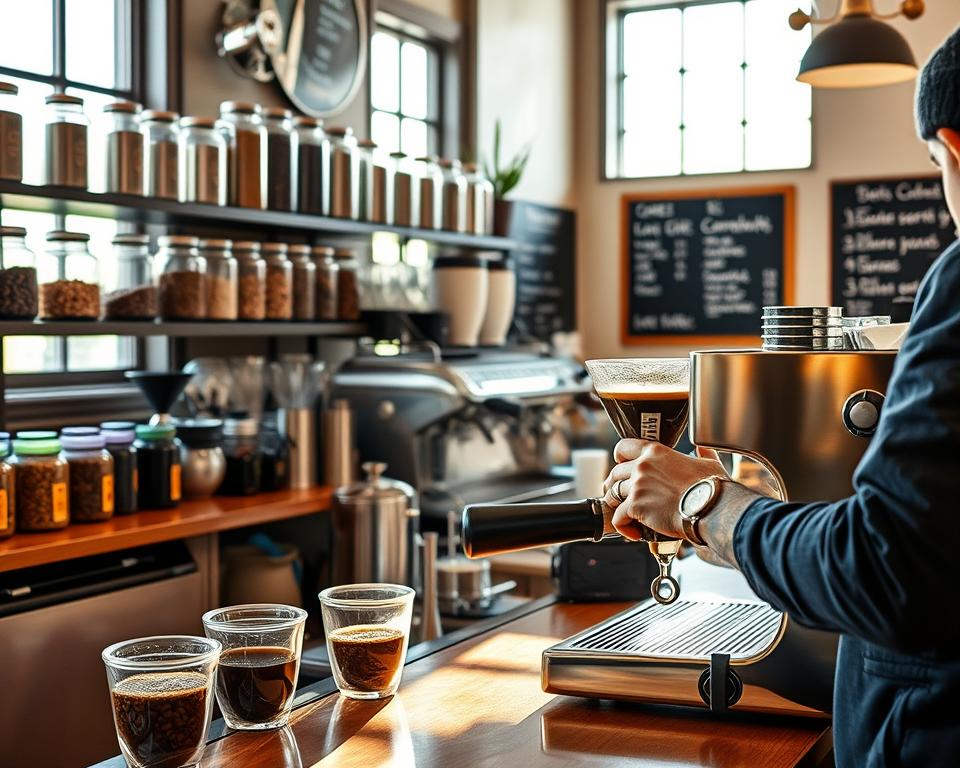Finding the perfect espresso coffee blend can be daunting with so many choices. To enhance your coffee experience, it’s vital to grasp the qualities of top-notch blends and seek out the finest espresso blends. Experts recommend classics like Intelligentsia Black Cat Classic Espresso and Stumptown Hair Bender for their unique flavors and superior beans. For more details, visit best espresso coffee blends online.
In your quest for the ideal espresso blend, consider the flavor profile, roast level, and freshness. Most espresso beans are 100% Arabica, but some Italian blends may include Arabica and Robusta. Lavazza Super Crema, priced at $22.31 for a 2.2-pound bag, offers a well-balanced taste. To discover your ideal blend, explore various options and consult reviews from trusted sources to pinpoint the best espresso blends for your taste.
Key Takeaways
- Understanding the characteristics of quality espresso coffee blends is crucial for a premium coffee experience.
- Exploring different flavor profiles, such as those found in Intelligentsia Black Cat Espresso and Stumptown Hair Bender, can help you find your perfect blend.
- Freshness and roast level play a significant role in the quality of espresso coffee blends.
- Traditional Italian espresso blends may contain a mix of Arabica and Robusta beans, while others are 100% Arabica.
- Reading reviews and trying different espresso coffee blends can help you determine the best option for your taste preferences.
- Espresso blends are reported to taste best after resting for five days to two weeks post-roasting, allowing the flavors to mature and develop.
- Specialty coffee, defined as coffee with a quality grading score of 80 percent or higher, is essential for a high-quality espresso experience.
What Are Espresso Coffee Blends?
Espresso coffee blends are a mix of various coffees, roasted and blended for a unique taste. They aim to be consistent all year, working well with different milks. Recent data shows “espresso beans” or “espresso blends” aren’t officially classified. Instead, these terms are used for marketing, not to signify a specific coffee type.
In the world of premium coffee blends, the focus is on balancing flavors. For instance, Brazil beans are known for their rich chocolate and creamy texture. Guatemala beans, on the other hand, are celebrated for their zippy acidity. Espresso blend reviews often stress the need to find the perfect flavor balance for personal taste.
Rumble Coffee is a notable name in espresso blends, offering three unique options: Shadow Boxer, Haymaker, and Street Fighter. Shadow Boxer is the darkest, with notes of chocolate and dark berries. Haymaker and Street Fighter bring flavors of orange and caramel, and blueberry and mandarin, respectively.
Choosing an espresso blend requires careful consideration of flavor and roast level. Light roasts can be floral and fruity but overpowering in espresso. Darker roasts might introduce burnt or fishy tastes. Opting for a high-quality espresso blend ensures a rich, balanced flavor that meets your taste preferences.
The Origins of Espresso Coffee
Espresso’s history stretches back to the early 20th century. The first espresso machine was patented by Luigi Bezzera in 1901. It could brew coffee in under a minute, starting espresso’s journey to global popularity.
The evolution of espresso is deeply connected to the advancement of espresso machines. Innovations have transformed the brewing process, leading to the high-quality espresso blends we enjoy today. From early machines to modern ones, the technology has significantly improved.
Notable milestones include Achille Gaggia’s spring lever machine in 1946, which raised brewing pressure to 14 bars. The 1960s and 1970s saw the introduction of electric pumps and dual boilers. These developments allowed for the creation of unique flavor profiles in top espresso blends.
Today, espresso is a global phenomenon, with espresso bars and cafes worldwide. The art of espresso preparation is steeped in tradition, focusing on the 4 Ms: Miscela (Blend), Macinazione (Grind), Macchina (Machine), and Mano (Hand). Whether you’re a coffee aficionado or simply enjoy espresso, knowing its origins can deepen your appreciation for its rich flavors and aromas.
Types of Espresso Coffee Blends
Espresso coffee blends vary, including single-origin and blended types. Single-origin coffees use beans from one region, while blended coffees mix different beans. This variety lets coffee enthusiasts explore unique flavors and discover their ideal cup. Artisan espresso blends, for example, offer a complex taste, with hints of dark chocolate and brown sugar.
The roast level greatly influences the flavor of espresso blends. A medium-dark roast can offer balanced acidity and a smooth body, perfect for espresso shots. Popular blends combine Brazilian, Guatemalan, and Ethiopian beans, delivering a rich, full-bodied taste. Skilled roasters carefully select and roast these beans to enhance the flavor.
For those seeking a stronger taste, darker espresso roast blends are a good choice. Yet, it’s crucial to remember that single-origin coffees might be too bright and acidic for espresso. Blended coffees can offer a more balanced taste. Coffee lovers can try various artisan espresso blends to find their perfect match.
Espresso coffee blends are known for their rich flavors, including notes of dark chocolate, brown sugar, and red berries. They often have a medium-dark roast level, providing balanced acidity and a smooth body. These blends are made from 100% Arabica coffee beans from regions like East Africa.
- Rich flavor profiles with notes of dark chocolate, brown sugar, and red berries
- Medium-dark roast level for balanced acidity and smooth body
- Blend of 100% Arabica coffee beans from various regions, such as East Africa
How to Choose the Right Espresso Blend
Choosing the best espresso blends involves several key factors. The flavor profile consistency is crucial. A reliable espresso blend should taste the same every time, regardless of the season or where it’s made. This is vital for those who seek consistent taste in their coffee.
Your taste preferences should guide your choice. Do you enjoy bold flavors or something more delicate? Espresso blend types vary widely. It’s important to find a blend that matches your taste. Opt for best espresso blends with high-quality beans and a balanced flavor.
The blend’s strength and roast level are also critical. Some prefer a robust flavor, while others prefer a milder taste. The roast level affects the taste, with darker roasts being more bitter and lighter roasts more acidic. When selecting an espresso blend, consider these factors:
- Flavor profile: Seek a blend with a balanced taste that aligns with your preferences.
- Strength: Choose a blend that meets your caffeine needs without overwhelming your senses.
- Roast level: Pick a blend with a roast level that enhances your taste preferences, whether light, medium, or dark.
By weighing these factors and selecting a high-quality espresso blend, you can enjoy a perfect cup of coffee every time. Whether you’re a seasoned coffee lover or new to espresso, finding the right blend significantly enhances your coffee experience.
| Espresso Blend Type | Flavor Profile | Strength | Roast Level |
|---|---|---|---|
| Single-Origin | Distinct, nuanced | Variable | Light to dark |
| Blended | Balanced, smooth | Medium to strong | Medium to dark |
The Importance of Freshness
Freshness is key to the quality and taste of premium coffee blends and espresso coffee blends. It’s crucial to know the shelf life of coffee beans and how to store them right. Coffee tastes best between 7 and 21 days after roasting, as its flavor and aroma decline over time.
Coffee beans have a short shelf life, with their quality dropping due to oxidation. This leads to a flavor loss known as “fade.” Keeping coffee in a cool, dry place, away from sunlight, helps preserve its freshness. Given that most people consume about one bag (12 ounces) of coffee weekly, it’s vital to store beans in an airtight container to keep their flavor and aroma intact.
Coffee Bean Shelf Life
The shelf life of coffee beans varies based on roast date, storage conditions, and packaging. Green coffee can stay high quality for up to a year, influenced by origin and bean variety. Yet, roasted coffee should be used within 2–4 weeks for the best taste. Some specialty coffees might need two to three weeks after roasting to reach their peak flavor.
How to Store Espresso Blends
To keep espresso coffee blends fresh, store them in an airtight container. Opened bags should be used within two weeks for optimal taste. Coffee should be stored in a cool, dry area, away from sunlight. The ideal moisture level for green coffee is between 9.5%–10.5%. Adhering to these storage tips ensures you enjoy the full flavor and aroma of your premium coffee blends and espresso coffee blends.
- Keep coffee in an airtight container
- Store coffee in a cool, dry space away from direct sunlight
- Use opened bags within two weeks for best results
- Monitor the moisture content of green coffee to ensure it’s between 9.5%–10.5%
Brewing Techniques for Espresso
The art of brewing espresso hinges on the right techniques and equipment. Espresso blend reviews highlight the importance of quality brewing alongside high-quality beans. To perfect the shot, understanding various brewing methods is crucial. This includes espresso machines and alternative methods.
For those seeking the best coffee blends, exploring different roasts and brewing techniques is a good starting point. With the right gear and practice, anyone can master brewing exceptional espresso. 
Espresso Machines
Espresso machines are crafted to produce high-pressure brews that highlight espresso blends’ unique flavors. The grind for espresso must be very fine, with an espresso-specific grinder recommended. Coffees like Big Trouble and Hologram are known for their consistent flavors, making them perfect for espresso recipes.
Alternative Brewing Methods
Methods like manual pour-overs and French press can also brew espresso. Manual pour-overs can make one to two cups at a time, with a brewing time of four to five minutes for full immersion. The grind for pour-overs should be finer for smaller cones and medium-coarse for larger brewers. AeroPress offers a clean, full-flavored experience, unlike French press which may leave grit.
Common Flavor Profiles in Espresso
Espresso blends showcase a broad spectrum of flavors, from the traditional to the exotic. Artisan espresso blends often present a more intricate and layered taste experience. A classic espresso roast blend typically exhibits a deeper flavor than regular coffee, with hints of chocolate and nuts.
The origin of coffee beans significantly influences the taste of espresso roast blends. For instance, beans from Africa can introduce fruity undertones, while those from Asia may bring earthy and spicy nuances. The roast level also plays a crucial role, with lighter roasts offering a brighter, more acidic taste and darker roasts delivering a bolder, more intense experience.
Chocolate and Nutty Notes
Chocolate and nutty flavors are staples in traditional espresso blends. These tastes are commonly found in Latin American coffees, known for their rich, smooth profiles. The chocolate notes can vary from milk to dark, while the nutty flavors span from almonds to hazelnuts.
Fruity and Bright Flavors
Fruity and bright flavors are prevalent in espresso blends, notably those featuring African coffee beans. These can include citrus, berries, tropical fruits, and floral notes. The blend’s bright acidity and fruity flavors contribute to a lively, refreshing taste, ideal for those who prefer a lighter, more vibrant espresso.
Popular Espresso Coffee Brands in the U.S.
In the U.S., the espresso market is flooded with brands, each with its own unique flavor profiles and blends. Starbucks and Peet’s Coffee stand out, known for their premium espresso bean blends. These brands have earned a dedicated following among coffee aficionados. Their top espresso blends are highly sought after, aiming to enhance the coffee experience.
The quality of coffee beans is crucial in espresso. Brands like Starbucks and Peet’s Coffee prioritize sourcing the finest beans for exceptional taste. They offer a wide variety of flavors and blends, catering to different tastes. This makes them a cornerstone in the U.S. coffee scene.
These brands are known for their commitment to quality, sustainability, and customer satisfaction. Starbucks is celebrated for its diverse espresso blends, while Peet’s Coffee is famous for its rich, full-bodied flavors. Whether you’re a seasoned coffee lover or new to espresso, these brands are an excellent starting point for finding your perfect cup of coffee.
When searching for the best espresso blends, consider factors like roast level, flavor profile, and brewing method. With numerous options, choosing the right blend can be daunting. Yet, opting for reputable brands like Starbucks and Peet’s Coffee ensures a high-quality product that will meet your espresso cravings.
Where to Buy Espresso Coffee Blends
Consumers have many options when looking to buy premium coffee blends, including espresso. Buying from local coffee roasters ensures freshness and quality. They source high-quality beans and roast them in small batches. This method offers a unique flavor profile, different from mass-produced coffee.
For those who prefer online shopping, learning about home coffee roasting is a good starting point. Online retailers offer a wide range of premium coffee blends, sourced from reputable roasters worldwide. Specialty coffee shops and online marketplaces are popular choices for coffee connoisseurs.
Buying from local coffee roasters has several benefits:
- Freshness: Local roasters roast and package in small batches, ensuring freshness.
- Quality: They carefully select and source high-quality beans, enhancing flavor.
- Supporting local businesses: Purchasing from local roasters supports the local community and economy.

Online retailers also provide a convenient way to buy premium coffee blends, including espresso. They offer detailed information about the coffee beans. This includes origin, roast level, and flavor profile, helping consumers make informed choices.
Pairing Food with Espresso Coffee
Exploring the world of pairing food with espresso coffee reveals a vast array of choices. With numerous espresso blend types to select from, deciding can be daunting. Fortunately, espresso blend reviews can guide you, helping to identify the ideal blend for your favorite meals.
Popular pairings include sweet treats like muffins, cakes, and cookies. For a savory twist, consider espresso with cheese, charcuterie, or a hearty breakfast. The goal is to harmonize the flavors and textures of both the food and coffee.
Here are some pairing ideas to spark your creativity:
- Sweet crepes with medium roast coffee
- Belgian waffles with cappuccino or latte
- Flan with dark roast coffee from Indonesia
Ultimately, the key is to experiment and discover the pairings that delight you the most. With an abundance of espresso blend types and food choices, the possibilities are limitless. By exploring different pairings and reading espresso blend reviews, you can enhance your coffee experience.
Exploring Flavored Espresso Blends
Flavored espresso blends introduce a unique twist to traditional espresso, offering a new dimension of taste and aroma. The market now boasts a wide array of flavors, from classic vanilla to exotic options like hazelnut and caramel. Artisan espresso blends stand out, providing a premium and distinctive taste that enhances the espresso experience.
Popular flavors include chocolate mint and caramel hazelnut. These can be used to craft various espresso-based drinks, such as lattes and cappuccinos. Espresso roast blend is also favored, known for its rich and full-bodied taste that complements different flavorings.
When selecting the best flavored espresso blend, consider your preferred flavor and desired sweetness level. Some blends are quite sweet, while others are more subtle. Artisan espresso blends, in particular, offer a high-quality and unique flavor profile that can elevate the espresso experience.
Recipes Featuring Espresso Coffee Blends
Espresso coffee blends are incredibly versatile, enhancing a wide array of recipes. They can transform classic coffee drinks into something extraordinary. Whether you’re drawn to the rich, chocolatey notes of a medium roast or the bold, fruit-forward flavors of a dark roast, there’s a world of possibilities. These best espresso blends can be seamlessly integrated into your cooking and baking.
For those who cherish traditional espresso, these blends are perfect for crafting the ideal shot, cappuccino, or Americano. They allow the beans’ natural complexity to take center stage. Whether you’re a barista or a home brewer, experimenting with ratios and extraction times can lead to a brew that perfectly suits your taste.
Espresso blends also shine in creative cocktail recipes. They can elevate everything from coffee-infused martinis to espresso-spiked Irish coffees. The bold, aromatic qualities of these blends add depth and sophistication to a variety of after-dinner drinks.
FAQ
What are espresso coffee blends?
What are the characteristics of quality espresso blends?
What is the history and evolution of espresso coffee?
What are the key coffee-producing regions that contribute to the flavor profiles of espresso blends?
What are the differences between single-origin and blended espresso coffees?
What are some popular espresso blend combinations?
How can I choose the right espresso blend for my taste preferences?
Why is freshness important for espresso coffee blends?
What are the best brewing techniques for espresso?
What are the common flavor profiles found in espresso blends?
What are some of the most popular espresso coffee brands in the U.S.?
Where can I buy high-quality espresso coffee blends?
What are the best food pairings for espresso coffee?
What are some popular flavored espresso blends?
How can I use espresso blends in recipes?

Paul Allen is a writer at WyNeeds, a website dedicated to the world of coffee. Passionate about aromas and flavors, he explores everything from the best brewing methods to fascinating insights about coffee beans and industry trends. His goal is to provide readers with engaging and informative content, helping both beginners and coffee enthusiasts deepen their knowledge of the world’s most beloved beverage.

